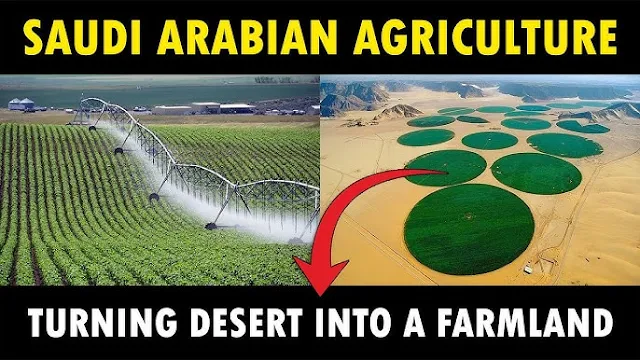Yes, agriculture is indeed practiced in the deserts of Saudi Arabia, although it presents significant challenges due to the arid climate and limited water resources. The Saudi government has invested heavily in the agricultural sector to achieve food security and reduce reliance on imports.
The following steps outline how agriculture is done in the deserts of Saudi Arabia:
Government Support and Subsidies: The Saudi government plays a crucial role in supporting agriculture through subsidies, long-term interest-free loans, and providing low-cost resources like water, fuel, and electricity. They also offer duty-free imports of raw materials and machinery to farmers.
Land Conversion and Irrigation: Large areas of desert have been converted into agricultural fields through major irrigation projects and large-scale mechanization. The country receives an average of 100mm of rain every winter, except in the southern part of the country, which is utilized for agriculture.
Water Sources: Since Saudi Arabia has no natural rivers, irrigation relies heavily on groundwater. Water is pumped from deep underground aquifers, some dating back to the last Ice Age. Center-pivot irrigation systems are commonly used to water crops.
Crop Selection: Farmers are focusing on crops that can thrive in harsh, dry conditions. These include crops like dates, which are a major export, as well as fruits, vegetables, and grains. There is also a shift towards desert-friendly crops that require less water.
Modern Techniques: Modern agricultural techniques are employed, including advanced irrigation systems like drip and subsurface irrigation to maximize water efficiency. Precision agriculture, using data from drones and sensors, is also utilized to optimize planting, watering, and fertilization.
Renewable Energy: Solar power is increasingly used to power irrigation systems and other farm operations, reducing reliance on traditional energy sources and lowering carbon emissions.
Soil Management: Efforts are being made to manage soil salinity, a significant challenge in desert agriculture. This includes using micro-irrigation, providing adequate drainage, and applying fertilizers judiciously.
Greenhouse Farming: Greenhouse farming is becoming increasingly popular. Greenhouses create a controlled environment that mitigates harsh climatic conditions, increases yields, and conserves water. Crops like Moringa, Edamame, Turmeric, Saffron, Basil, and Chili Peppers are being cultivated in greenhouses.
International Collaboration: Saudi Arabia collaborates with international experts and researchers to bring in the best ideas and technologies for sustainable agriculture. This includes joint research initiatives and knowledge exchange programs.
Circular Farming: Circular farming models are being implemented, such as the one by Tanmiah Food Company, which recycles wastewater for irrigation and uses drought-tolerant trees like Moringa for animal feed. This approach aims to create a regenerative system that addresses water scarcity, land degradation, and food security challenges.
Land Acquisition Abroad: Due to water depletion, Saudi Arabia has also invested in acquiring agricultural land in other countries to secure food supplies.
In summary, agriculture is done in the deserts of Saudi Arabia through a combination of government support, advanced irrigation techniques, the cultivation of drought-resistant crops, the use of renewable energy, and international collaborations. These efforts are aimed at achieving food security and promoting sustainable agricultural practices in a challenging environment.

